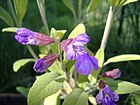Note: This is a project under development. The articles on this wiki are just being initiated and broadly incomplete. You can Help creating new pages.
Salvia officinalis
Sage is an evergreen, much-branched, shrub growing 50 - 100cm tall. A very ornamental plant, sage is commonly grown in the herb garden for culinary and medicinal purposes.
Contents
[hide]- 1 Uses
- 2 Parts Used
- 3 Chemical Composition
- 4 Common names
- 5 Properties
- 6 Habit
- 7 Identification
- 8 List of Ayurvedic medicine in which the herb is used
- 9 Where to get the saplings
- 10 Mode of Propagation
- 11 How to plant/cultivate
- 12 Commonly seen growing in areas
- 13 Photo Gallery
- 14 References
- 15 External Links
Uses
Night sweats, Excessive salivation, Anxiety, Depression, Female sterility, Menopausal problems, Insect bites, Throat infections, Skin infections, Mouth infections.[1]
Parts Used
Chemical Composition
It contains main components of the oil include borneol, camphor, caryophyllene, cineole, elemene, humulene, ledene, pinene, and thujone.9, 12, 13 Alcoholic and aqueous extracts of S. officinalis are rich in flavonoids particularly rosmarinic acid and luteolin-7-glucoside.[2]
Common names
| Language | Common name |
|---|---|
| Kannada | |
| Hindi | |
| Malayalam | |
| Tamil | |
| Telugu | |
| Marathi | |
| Gujarathi | |
| Punjabi | |
| Kashmiri | |
| Sanskrit | |
| English |
Properties
Reference: Dravya - Substance, Rasa - Taste, Guna - Qualities, Veerya - Potency, Vipaka - Post-digesion effect, Karma - Pharmacological activity, Prabhava - Therepeutics.
Dravya
Rasa
Guna
Veerya
Vipaka
Karma
Prabhava
Habit
Identification
Leaf
| Kind | Shape | Feature |
|---|---|---|
Flower
| Type | Size | Color and composition | Stamen | More information |
|---|---|---|---|---|
| {{{5}}} |
Fruit
| Type | Size | Mass | Appearance | Seeds | More information |
|---|---|---|---|---|---|
Other features
List of Ayurvedic medicine in which the herb is used
Where to get the saplings
Mode of Propagation
Seeds, Cuttings of heeled shoots, Cuttings of half-ripe wood, Cuttings of mature wood, Layering in spring.
How to plant/cultivate
A plant of the temperate to subtropical zones, it can be cultivated at elevations above 500 metres in the drier regions of the tropics.[4]
Commonly seen growing in areas
On dry banks, On stony places.
Photo Gallery
References
- Jump up ↑ Indian Medicinal Plants by C.P.Khare
- Jump up ↑ Chemical constituents
- Jump up ↑ [Morphology]
- Jump up ↑ Cultivation
External Links
- Ayurvedic Herbs known to be helpful to treat Night sweats
- Ayurvedic Herbs known to be helpful to treat Excessive salivation
- Ayurvedic Herbs known to be helpful to treat Anxiety
- Ayurvedic Herbs known to be helpful to treat Depression
- Ayurvedic Herbs known to be helpful to treat Female sterility
- Ayurvedic Herbs known to be helpful to treat Menopausal problems
- Ayurvedic Herbs known to be helpful to treat Insect bites
- Ayurvedic Herbs known to be helpful to treat Throat infections
- Ayurvedic Herbs known to be helpful to treat Skin infections
- Ayurvedic Herbs known to be helpful to treat Mouth infections
- Herbs with Leaves used in medicine
- Herbs with Flowers used in medicine
- Habit - Evergreen shrub
- Index of Plants which can be propagated by Seeds
- Index of Plants which can be propagated by Cuttings of heeled shoots
- Index of Plants which can be propagated by Cuttings of half-ripe wood
- Index of Plants which can be propagated by Cuttings of mature wood
- Index of Plants which can be propagated by Layering in spring
- Herbs that are commonly seen in the region of On dry banks
- Herbs that are commonly seen in the region of On stony places
- Herbs






